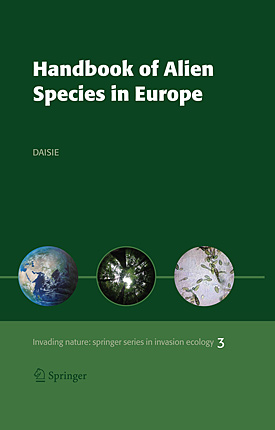Press release from November 21st, 2008
11,000 alien species invade Europe
A comprehensive overview
Halle/Saale. For the first time it is now possible to get a comprehensive overview of which alien species are present in Europe, their impacts and consequences for the environment and society. More than 11,000 alien species have been documented by DAISIE (Delivering Alien Invasive Species Inventory for Europe), a unique three year research project with more than 100 European scientists, funded by the European Union that provides new knowledge on biological invasions in Europe. Biological invasions by alien species often result in a significant loss in the economic value, biological diversity and function of invaded ecosystems.

Handbook of Alien Species in Europe
Source: Springer Publishing House
Harmful visitors
The majority of these 11,000 alien species are however, not harmful. About 15 percent of these alien species cause economic damages and 15 percent cause harm to biological diversity, that is the environment, habitats and native plants, animals and micro-organisms, according to findings in the newly released and freely accessible web portal at www.europe-aliens.org and the DAISIE "Handbook of alien species in Europe" that is launched this week.
Knowledge enables action
Previous to the publication of the results of the DAISIE project, the number and impacts of harmful alien species (also called invasive alien species) in Europe has been underestimated, especially for species that do not damage agriculture, forestry or human health. The lack of knowledge has contributed to inaction in many European countries which is becoming increasingly disastrous for Europe’s biodiversity, health and economy.
Why do we need the information?
Alien species may have a profound impact on the environment and society as they can act as vectors for new diseases, alter ecosystem processes, change biodiversity, disrupt cultural landscapes, reduce the value of land and water for human activities and cause other socio-economic consequences. Alien species are plants, animals and micro-organisms that have been moved by humans to new environments outside of the range they occupy naturally.
Supporting qualified decisions
Information in this week published DAISIE "Handbook of Alien Species in Europe" and the internet accessible knowledge base provides an important tool for managing the threat of biological invasion in Europe. Information in DAISIE can be used for documenting current invasions, predicting new invasions and preventing future invasions. Crucial information for planning measures for early detection, eradication and control methods is also provided to decision-makers, environmental planners, students and all concerned.
Publication:
DAISIE (2009) Handbook of alien species in Europe. Springer, Dordrecht
ISBN 978-1-4020-8279-5, available by 17 November 2008
www.springer.com/life+sci/ecology/book/978-1-4020-8279-5
For more information on the DAISIE "Handbook on alien species in Europe" please contact
Prof. Wolfgang Nentwig
University of Bern, Switzerland
wolfgang.nentwig@zos.unibe.ch
Telephone 0041 31 631-4520
Dr. Montserrat Vilà
Estación Biológica de Doñana, Sevilla, Spain
montse.vila@ebd.csic.es
Telephone +34 954 232340 ext. 123
Dr. Petr Pyšek
Institute of Botany, Průhonice, Academy of Sciences of the Czech Republic, Praha
pysek@ibot.cas.cz
Telephone +420 271015266
Prof. Philip E. Hulme
National Centre for Advanced Bio-Protection Technologies, Lincoln University, New Zealand
[§getmail_hulmep@lincoln.ac.nz§)
Telephone (64) (3) 325 3696 ext. 8317
For more information on the DAISIE project, please contact:
Dr. Melanie Josefsson
Swedish Environmental Protection Agency
melanie.josefsson@snv.slu.se
Telephone +46 8 698 1541
Dr. David Roy
Biological Records Centre, CEH Wallingford, United Kingdom
dbr@ceh.ac.uk
Telephone :+44 1491 692517
More information:
Dr. Stefan Klotz
Helmholtz Centre for Environmental Research (UFZ)
Telephone: +49 345 558-5302
Dr. Stefan Klotz
Dr. Ingolf Kühn
Helmholtz Centre for Environmental Research (UFZ)
Telephone: +49 345 558-5311
Dr. Ingolf Kühn
or
Helmholtz Centre for Environmental Research (UFZ)
Pressoffice
Tilo Arnhold
Telephone: +49 341 235 1269
presse@ufz.de
Links:
DAISIE knowledge base:
www.europe-aliens.org
Significant increase in alien plants in Europe (Press release September 17, 2008):
www.ufz.de/index.php?de=17176
At the Helmholtz Centre for Environmental Research (UFZ) scientists research the causes and consequences of far-reaching environmental changes. They study water resources, biological diversity, the consequences of climate change and adaptation possibilities, environmental and biotechnologies, bio energy, the behaviour of chemicals in the environment and their effect on health, as well as modelling and social science issues. Their guiding research principle is supporting the sustainable use of natural resources and helping to secure these basic requirements of life over the long term under the influence of global change. The UFZ employs 900 people at its sites in Leipzig, Halle and Magdeburg. It is funded by the German government and by the states of Saxony and Saxony-Anhalt.
The Helmholtz Association helps solve major, pressing challenges facing society, science and the economy with top scientific achievements in six research areas: Energy, Earth and Environment, Health, Key Technologies, Structure of Matter, Transport and Space. With 25,700 employees in 15 research centres and an annual budget of around EUR 2.3 billion, the Helmholtz Association is Germany’s largest scientific organisation. Its work follows in the tradition of the great natural scientist Hermann von Helmholtz (1821-1894).
